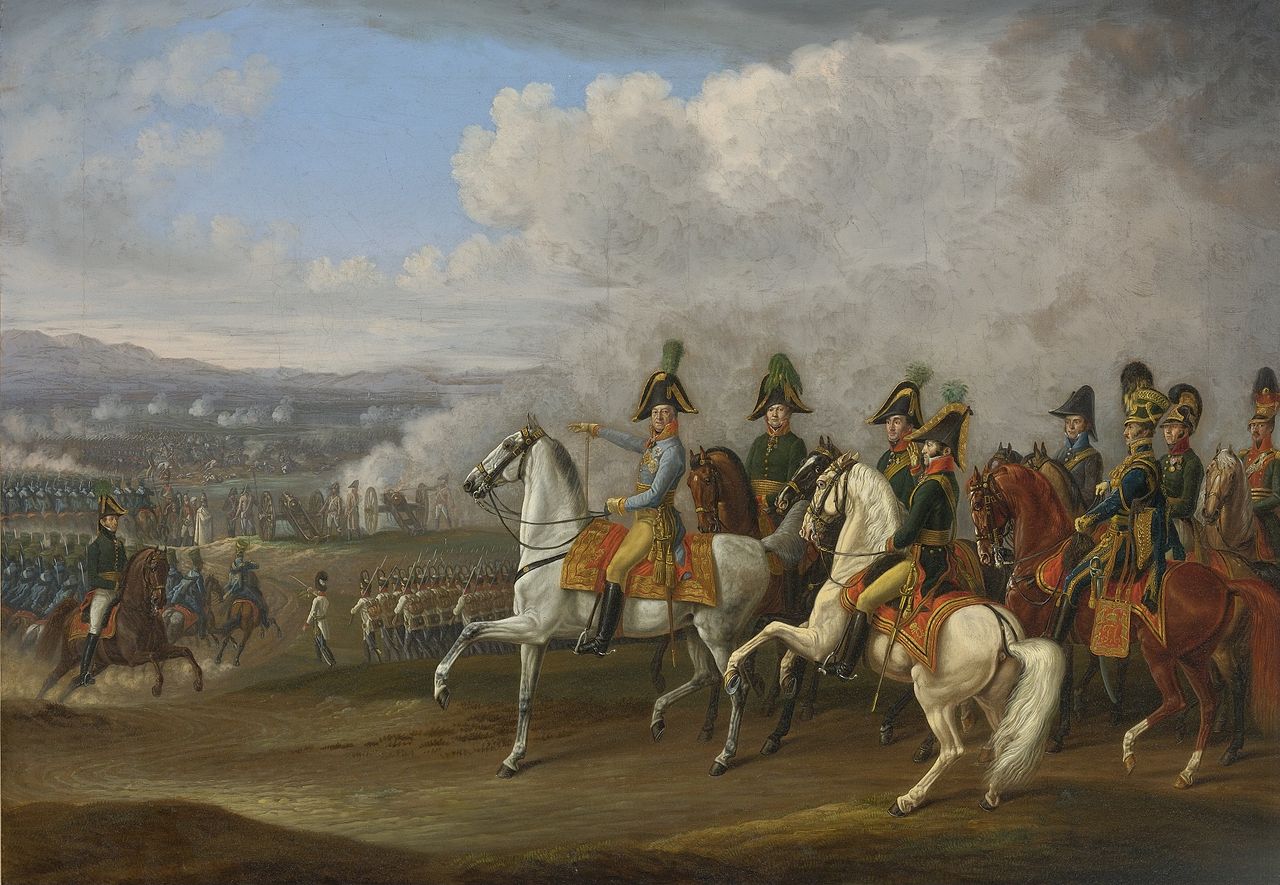
Field Marshal Heinrich von Bellegarde and his staff at the battle of the Mincio River, by Albrecht Adam.
The Battle of the Mincio River (or Roverbella, a village some miles north of Mantua) was fought between the Armée d’Italie under Eugene de Beauharnais, Viceroy of the Kingdom of Italy, and an Austrian army under Feldmarschall Heinrich Graf Bellegarde. Though tactically a draw (neither party claimed victory in official reports), it was a French victory at the strategic level, as the Austrians failed to force the line of the Mincio.
The 1813-1814 Italian campaigns had begun in September 1813 with the Armée d’Italie defending the Illyrian Provinces (parts of present-day Slovenia and Croatia) and the Drava Valley in Styria (now southern Austria and northern Slovenia). A slow and relatively uncontested re- treat followed in the autumn, with bad weather and the lethargic Austrians allowing Eugene to successfully defend the line behind the river Adige for three months. On 4 February 1814, being aware that the King of Naples, Joachim Murat, had recently passed over to the Allied coalition and that his Austro-Neapolitan army threatened the French line of communication on the southern bank of the Po, Eugene ordered a retreat behind the Mincio. The new defensive line, supported on both flanks by the fortresses of Peschiera (to the north) and Mantua (to the south), al- lowed the Armée d’Italie to shorten its front considerably and maintain a central position between Bellegarde and Murat. Eugene’s plan was to move quickly most of his army south of the Po and fall on the Neapolitans. To achieve this goal, he had first to paralyze Bellegarde’s army, positioned at Villafranca, by delivering an unexpected blow across the Mincio on 8 February. For his part, Bellegarde erroneously believed that Eugene was fleeing to Cremona and decided to set off in pursuit. The Austrian army was to cross the Mincio at Valeggio early in the morning of the same day.
Bellegarde had under his command 35,000 generally well-seasoned troops, with 130 guns. Eugene’s was essentially a conscript army of 30,000 men, excluding the troops left in garrison at Mantua and Peschiera, with 90 guns. With morning mist preventing the opposing commanders from detecting each other’s positions, the battle developed symmetrically over two distinct areas 5-6 miles apart and separated by the Mincio. While most of Eugene’s army (19,000 men) pushed northeast from Goito toward Villafranca, clashing with Bellagarde’s reserve, the bulk of the Austrian army crossed to the right bank and ran into a single French division positioned on the hills of Monzambano.
By midmorning, an amazed Eugene realized Austrian intentions and reacted to the unusual situation facing him. Hoping to catch the Austrians off balance and fall on their left flank, he redirected at about 10:00 A. M. three French infantry divisions, with one light cavalry brigade and the cavalry of the Italian Royal Guard, toward Valeggio. His advance, however, was checked by Generalmajor Joseph Freiherr von Stutterheim’s grenadier brigade (with two dragoon regiments), which stubbornly resisted against greater odds until late afternoon on the heights of the village of Pozzolo, midway between Goito and Valeggio.
On the far bank, General Philibert Fressinet’s small French division (5,000) was deployed on higher ground along the Olfino stream and successfully repulsed every enemy effort. Fearing for his rear, Bellagarde eventually ordered a general retreat eastward across the Mincio. Eugene’s army encamped for the night somewhere between Pozzolo and Roverbella, and on the following morning withdrew to its original position behind the river. During the battle, two small Italian divisions launched minor and indecisive sorties from Peschiera and Mantua. The Austrians had some 4,000 men killed and wounded, and 2,500 taken prisoner. French losses lay somewhere between the Austrian claim of 6,000 and Eugene’s figure of 2,500.
References and further reading Nafziger, George F., and Marco Gioannini. 2002. The Defense of the Napoleonic Kingdom of Northern Italy, 1813-1814. Westport, CT: Praeger. Schneid, Frederick C. 2002. Napoleon’s Italian Campaigns, 1805-1815. Westport, CT: Greenwood. Weil, Maurice. 1902. Le prince Eugene et Murat, 1813-1814: Opérations militaires, négociations diplomatiques. Paris: Fontemoing.